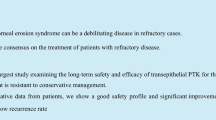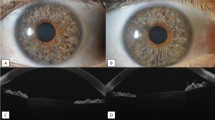Abstract
To study the efficacy and safety of sutureless amniotic membrane transplantation combined with narrow-strip conjunctival autograft and to investigate the clinical outcomes. Thirty eyes of 30 patients with primary pterygia were treated in this institutional study with excision followed by sutureless amniotic membrane transplantation combined with narrow-strip conjunctival autograft using fibrin glue tissue adhesive. The main outcome measures were the operating time for ocular surface reconstruction, the size of the pterygium and of the conjunctival autograft, postoperative complications, subjective complaints, and recurrences. The mean pterygium size was 3.12 ± 0.92 mm and the mean operating time was 4.58 ± 1.10 min. Twenty-nine patients (96.7%) had no complaints after first postoperative week. Twenty-eight (93.3%) patients had no recurrences after 1 year follow-up. The sutureless amniotic membrane transplantation combined with narrow-strip conjunctival autograft is an effective procedure with low rate of recurrence. This technique can be considered as a preferred grafting procedure for primary pterygium but further randomized controlled studies including larger populations are needed.




Similar content being viewed by others
References
Taylor HR, West S, Muñoz B, Rosenthal FS, Bressler SB, Bressler NM (1992) The long-term effects of visible light on the eye. Arch Ophthalmol 110(1):99–104
Hirst LW (2003) The treatment of pterygium. Surv Ophthalmol 48(2):145–180
Moran DJ, Hollows FC (1984) Pterygium and ultraviolet radiation: a positive correlation. Br J Ophthalmol 68(5):343–346
Detorakis ET, Spandidos DA (2009) Pathogenetic mechanisms and treatment options for ophthalmic pterygium: trends and perspectives. Int J Mol Med 23(4):439–447
Hirst LW, Sebban A, Chant D (1994) Pterygium recurrence time. Ophthalmology 101(4):755–758
Ang LP, Chua JL, Tan DT (2007) Current concepts and techniques in pterygium treatment. Curr Opin Ophthalmol 18(4):308–313
Wu PC, Kuo HK, Tai MH, Shin SJ (2009) Topical bevacizumab eyedrops for limbal-conjunctival neovascularization in impending recurrent pterygium. Cornea 28(1):103–104
Razeghinejad MR, Hosseini H, Ahmadi F, Rahat F, Eghbal H (2010) Preliminary results of subconjunctival bevacizumab in primary pterygium excision. Ophthalmic Res 43(3):134–138
Díaz L, Villegas VM, Emanuelli A, Izquierdo NJ (2008) Efficacy and safety of intraoperative mitomycin C as adjunct therapy for pterygium surgery. Cornea 27(10):1119–1121
Frucht-Pery J, Siganos CS, Ilsar M (1996) Intraoperative application of topical mitomycin C for pterygium surgery. Ophthalmology 103(4):674–677
Bahar I, Kaiserman I, Weisbrod M, McAllum P, Slomovic A (2008) Extensive versus limited pterygium excision with conjunctival autograft: outcomes and recurrence rates. Curr Eye Res 33(5):435–440
Biedner B, Rosenthal G (1996) Conjunctival closure in strabismus surgery: vicryl versus fibrin glue. Ophthalmic Surg Lasers 27(11):967
Panda A, Kumar S, Kumar A, Bansal R, Bhartiya S (2009) Fibrin glue in ophthalmology. Indian J Ophthalmol 57(5):371–379
Por YM, Tan DT (2010) Assessment of fibrin glue in pterygium surgery. Cornea 29(1):1–4
Shimazaki J, Yang HY, Tsubota K (1997) Amniotic membrane transplantation for ocular surface reconstruction in patients with chemical and thermal burns. Ophthalmology 104(12):2068–2076
Fernandes M, Sridhar MS, Sangwan VS, Rao GN (2005) Amniotic membrane transplantation for ocular surface reconstruction. Cornea 24(6):643–653
Tekin NF, Kaynak S, Saatci SO, Cingil G (2001) Preserved amniotic membrane transplantation in the treatment of primary pterygium. Ophthalmic Surg Lasers 32(6):464–469
Katircioğlu YA, Altiparmak UE, Duman S (2007) Comparison of three methods for the treatment of pterygium: amniotic membrane graft, conjunctival autograft and conjunctival autograft plus mitomycin C. Orbit 26(1):5–13
Luanratanakorn P, Ratanapakorn T, Suwan-Apichon O, Chuck RS (2006) Randomised controlled study of conjunctival autograft versus amniotic membrane graft in pterygium excision. Br J Ophthalmol 90(12):1476–1480
Solomon A, Pires RT, Tseng SC (2001) Amniotic membrane transplantation after extensive removal of primary and recurrent pterygia. Ophthalmology 108(3):449–460
Shimazaki J, Shinozaki N, Tsubota K (1998) Transplantation of amniotic membrane and limbal autograft for patients with recurrent pterygium associated with symblepharon. Br J Ophthalmol 82(3):235–240
Jain AK, Bansal R, Sukhija J (2008) Human amniotic membrane transplantation with fibrin glue in management of primary pterygia: a new tuck-in technique. Cornea 27(1):94–99
Dupps WJ Jr, Jeng BH, Meissler DM (2007) Narrow-strip conjunctival autograft for treatment of pterygium. Ophthalmology 114(2):227–231
Alpay A, Uğurbaş SH, Erdoğan B (2009) Comparing techniques for pterygium surgery. Clin Ophthalmol 3:69–74
Ozer A, Yildirim N, Erol N, Yurdakul S (2009) Long-term results of bare sclera, limbal-conjunctival autograft and amniotic membrane graft techniques in primary pterygium excisions. Ophthalmologica 223(4):269–273
Ayala M (2008) Results of pterygium surgery using a biologic adhesive. Cornea 27(6):663–667
Koranyi G, Seregard S, Kopp ED (2005) The cut-and-paste method for primary pterygium surgery: long-term follow-up. Acta Ophthalmol Scand 83(3):298–301
Karalezli A, Kucukerdonmez C, Akova YA, Altan-Yaycioglu R, Borazan M (2008) Fibrin glue versus sutures for conjunctival autografting in pterygium surgery: a prospective comparative study. Br J Ophthalmol 92(9):1206–1210
Srinivasan S, Dollin M, McAllum P, Berger Y, Rootman DS, Slomovic AR (2009) Fibrin glue versus sutures for attaching the conjunctival autograft in pterygium surgery: a prospective observer masked clinical trial. Br J Ophthalmol 93(2):215–218
Hall RC, Logan AJ, Wells AP (2009) Comparison of fibrin glue with sutures for pterygium excision surgery with conjunctival autografts. Clin Experiment Ophthalmol 37(6):584–589
Kucukerdonmez C, Akova YA, Altınors DD (2007) Comparison of conjunctival autograft with amniotic membrane transplantation for pterygium surgery: surgical and cosmetic outcome. Cornea 26(4):407–413
Kawamura M, Sawafuji M, Watanabe M, Horinouchi H, Kobayashi K (2002) Frequency of transmission of human parvovirus B19 infection by fibrin sealant used during thoracic surgery. Ann Thorac Surg 73(4):1098–1100
Oswald AM, Joly LM, Gury C, Disdet M, Leduc V, Kanny G (2003) Fatal intraoperative anaphylaxis related to aprotinin after local application of fibrin glue. Anesthesiology 99(3):762–763
Ozdamar Y, Mutevelli S, Han U, Ileri D, Onal B, Ilhan O et al (2008) A comparative study of tissue glue and vicryl suture for closing limbal-conjunctival autografts and histologic evaluation after pterygium excision. Cornea 27(5):552–558
Acknowledgment
The authors have no financial interest on any of the materials mentioned in the study.
Author information
Authors and Affiliations
Corresponding author
Rights and permissions
About this article
Cite this article
Taylan Sekeroglu, H., Erdem, E., Dogan, N.C. et al. Sutureless amniotic membrane transplantation combined with narrow-strip conjunctival autograft for pterygium. Int Ophthalmol 31, 433–438 (2011). https://doi.org/10.1007/s10792-011-9488-y
Received:
Accepted:
Published:
Issue Date:
DOI: https://doi.org/10.1007/s10792-011-9488-y




